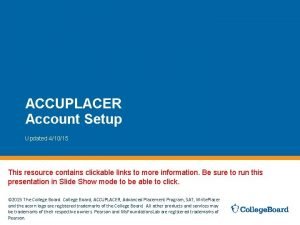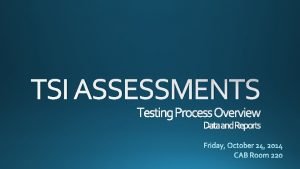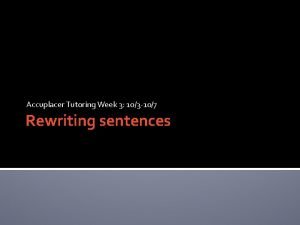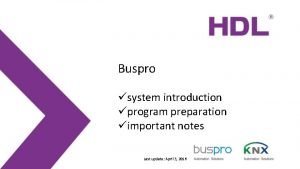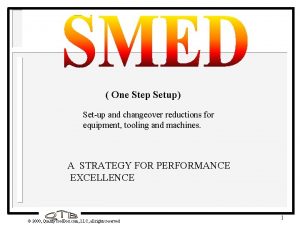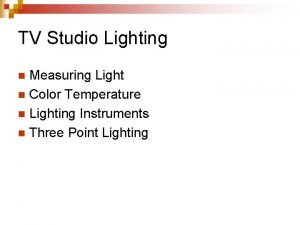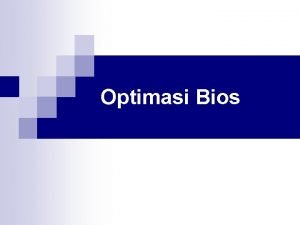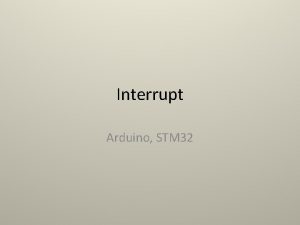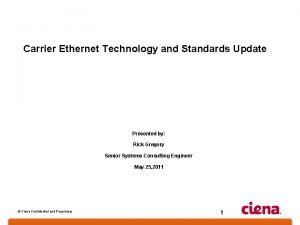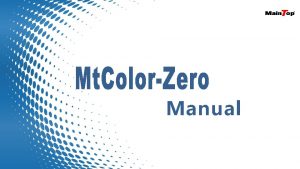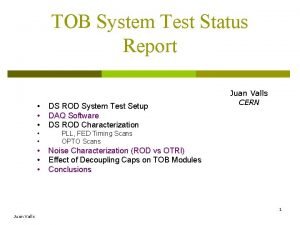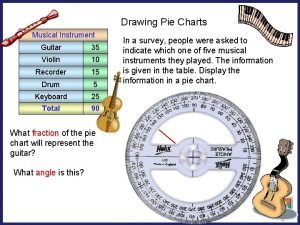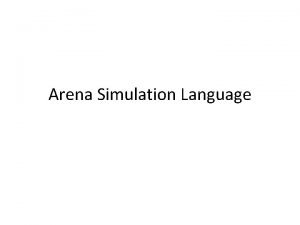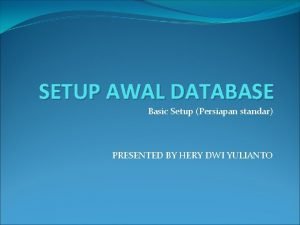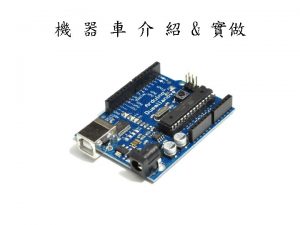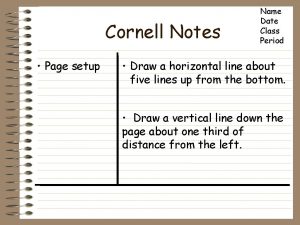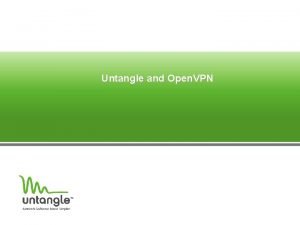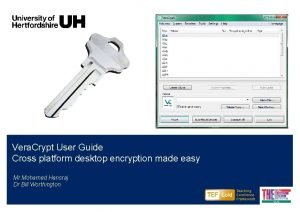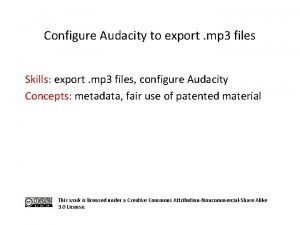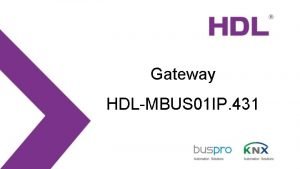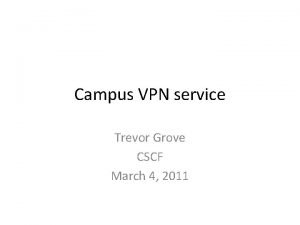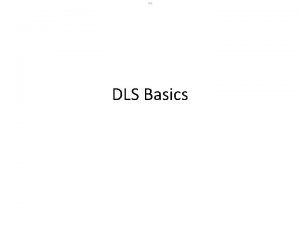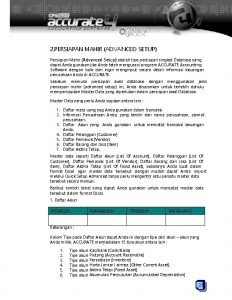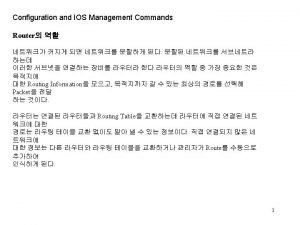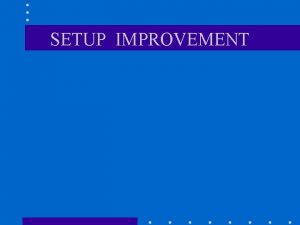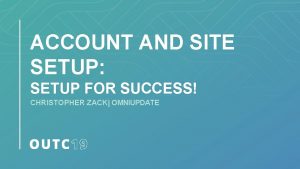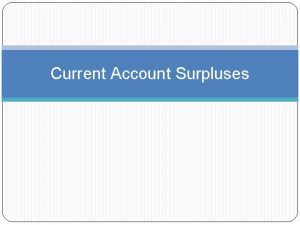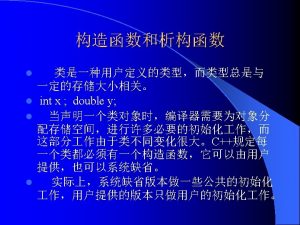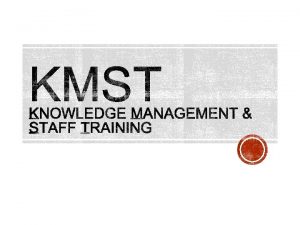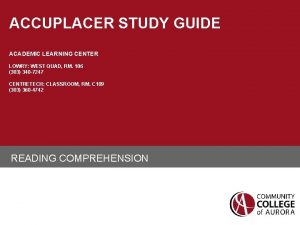ACCUPLACER Account Setup Updated 41015 This resource contains





























































































- Slides: 93

ACCUPLACER Account Setup Updated 4/10/15 This resource contains clickable links to more information. Be sure to run this presentation in Slide Show mode to be able to click. © 2015 The College Board, ACCUPLACER, Advanced Placement Program, SAT, Write. Placer and the acorn logo are registered trademarks of the College Board. All other products and services may be trademarks of their respective owners. Pearson and My. Foundations. Lab are registered trademarks of Pearson.

Planning for ACCUPLACER

ACCUPLACER Account Setup ► Setting up an ACCUPLACER account for testing requires decision-making regarding: • Purpose of testing • Account structure • Personnel with account access • Tests to be given • Options for testing • Cut scores and placement policies • Reporting and use of data

Resources to Support Making Implementation Decisions ► ACCUPLACER provides resources to support implementation decisions • Demo Site ► 25 complementary test units for faculty preview ► Faculty data kept separate from your real student data ► • Create proctor user assigned to the Demo Site – follow the instructions for creating a new user Resources ► Program Manual with test blueprints, proficiency statements, and sample placement policies ► User’s Guide which contains more information on account setup ► Follow the instructions for accessing the Resources function

Typical Account Setup Workflow Make appropriate implementation decisions Request ACCUPLACER account Create Testing Site(s) Add Users (Staff) Create Branching Profile(s) Create Placement Rules (if used) Order Test Units Test Students Reporting and Data Analysis

The ACCPLACER Interface

Understanding the Screen Search Tools User ID, Profile, Password, and Logout Options Search tools with available options dependent on selected function Navigation Pane shows functions and options available Add Search Results Click to Add a new entry Search results Action Icons to perform operations such as View, Edit, or Print an entry. Options depend on the contents of the results. Scroll to bottom of any screen for contact options to reach ACCUPLACER Support

Understanding the Screen Search Tools Navigation Pane shows functions and options available User ID, Profile, Password, and Logout Options Search tools with available options dependent on selected function Click to Add a new entry Scroll to bottom of any screen for contact Search results options to reach ACCUPLACER Support Action Icons to perform operations such as View, Edit, or Print an entry. Options depend on the contents of the results.

Navigation is through the Navigation pane on the left hand side of the screen. Arrowhead indicates current location. Click a Function to access available options. Click the down arrow to find sub-menu options.

Finding Resources and Help Resources available within ACCULACER include the Quick Start Guide, Program Manual and User’s Guide. Check What’s New for announcements about upcoming additions to ACCUPLACER and planned maintenance. Use Live Chat to immediately connect with Support for assistance. Contact options for ACCUPLACER Support are at the bottom of every screen.

Working with Search Results Click the + sign to expand an entry. Click the - sign to collapse an entry. Click action icons to edit, delete, and perform other operations on selected list entry.

Working with Student Search Results • Several options allow you to search for students to perform a desired action • Beside each student’s entry is a Gear icon. Use it to choose the appropriate action. Manage Test Sessions Test Center Management Dashboard

Using This Resource ► This resource covers the process and detailed steps involved in setting up a new ACCUPLACER account. Each section discusses a particular feature, provides a lists of steps, and links to a video demonstration of those steps. ► You can work through the slide deck in order or use an index to jump around as necessary. ► There are 2 different indices available for navigation: ► ü The Basic Index covers the standard setup of an account for testing and course placement. ü The Advanced Index covers additional options which may be necessary for institutions who wish to customize testing, place students with multiple measures, or pre-register students to test with vouchers. On the final screen of each section will be links back to the index and to the video demonstration.

Viewing the Videos • When you click the link, videos will open in a new web browser window. • Videos have sound so be sure to adjust your audio. • To see the full detail in the video, expand the size to full screen. • Transcripts are available. Click for Video Transcript Click to play in full screen

Basic Account Setup and Operation To set up a new ACCUPLACER account, work through the steps listed in order. To review specific parts of the setup process, click the link to jump to that section. The sections below cover the basic set up and operation of an account. The index on the next slide discuss advanced details. 1. 2. 3. 4. 5. Verify System Requirements Testing Sites * 1. Creating and Editing Testing Sites 2. Transferring Test Units Users 1. Creating a New User Branching Profiles 1. Branching Profiles Placement Rules 1. Course Groups 2. Courses 3. Placement Rules Verify Branching Profile/Placement Rules 7. Proctoring Testing 1. Starting a New Test 2. Continuing an Open Test 3. Re-opening a Closed Test 8. Reporting 1. Individual Score Report 2. Roster Reports 9. User Resources 10. Contacting ACCUPLACER 6. Advanced Index * Institution Administrator functions only.

Advanced Account Setup and Operation The list covers more advanced operation of an ACCUPLACER account. 1. 2. 3. 4. Users 1. Editing an Existing User Branching Profiles 1. Test Settings 2. Background Questions 3. Write. Placer Placement Rules 1. Majors 2. User Defined Fields 3. Composite Scores Proctoring Testing 1. Student Pre-Registration 2. Generating Vouchers 3. Reprinting Vouchers 4. Testing with Vouchers 5. Testing with Fast Track Basic Index

Verify System Requirements

Checking System Requirements 1. Go to www. accuplacer. org 2. Click the Verify System Requirements button at the bottom of the screen. 3. A listing of the various requirements will display along with information about the specific computer being used. 4. Versions that are higher than the minimum required may show as “Fail” but will function. Versions that are lower than the minimum must be addressed by IT. 5. Test content uses pop-up windows which must be allowed for ACCUPLACER.

Checking System Requirements Basic Index Advanced Index Video

Account Hierarchy

ACCUPLACER Account Hierarchy The ACCUPLACER platform maintains a hierarchy of account levels designed to allow for wide scale use across systems and states while protecting data and privacy. ► Levels of the hierarchy • College Board • Group – used primarily by statewide systems • Institution • Testing Site ► Test Settings, Branching Profiles, Placement Rules created at higher levels are available at lower levels of the hierarchy. Those items cannot be changed, but can be copied and edited, or inactivated. ► Student results including test scores and placement results are available to users at higher levels of the hierarchy.

The College Board level provides resources to all users in the ACCUPLACER platform including default settings and tests. Group Administration Institution A The Testing Site Level is used to test students and manage student data and results. An Institution Administrator creates Testing Sites. College Board Level Items created at the College Board level begin with ***. The Group Level can be used for system or statewide implementations to provide centralized account setup created and data access. Most institutions are. Items not part of a at the Group level begin Group. with **. Institution B Data flows to higher levels Settings, Branching Profiles, Placement Rules flow to lower levels Account Hierarchy Items created atcampuses the The Institution Level is used for individual Institution level begin or systems. New accounts are created at this level. Testing Site A Testing Site B with *. Items created at the Testing Site Level cannot be shared with other Testing Sites.

A Typical Account Structure IA Campus A Testing Site Campus B Testing Site High School Testing Site ABE Testing Site Research Testing Site Faculty Testing Site Unlimited sites available in the system Allows data collection state or system-wide, or by individual site

Testing Sites

Testing Sites ► Your new ACCUPLACER account was created at the top level known as the Institution level. Credentials were sent to the primary contact called the Institution Administrator. ► Testing Sites must be created in an ACCUPLACER account to test students. Testing sites protect student privacy by allowing only authorized users to access data in a testing site. ► Testing Sites can be created based on physical location such as the North campus and East campus, or can be based on a specific program such as testing for placement on a college campus, testing during a summer boot camp, or testing in high schools.

Testing Sites 1. Click the Users function. 2. Click the Manage Profiles sub-menu. 3. Click the Testing Sites option. 4. A list of existing Testing Sites will display. 5. To edit an existing Testing Site, click the Edit action icon to the right of the entry. 6. To create a new Testing Site, click the Add button. 7. Complete or edit the on-screen form. 8. Required fields show a red asterisk (*). 9. Click the Save button. Basic Index Advanced Index Video

Transfer Test Units This features allows an Institution Administrator to move Test Units between Testing Sites. 1. Click the Users function. 2. Click the Transfer Test Units option. 3. On the left side, choose the Testing Site to move units from, then enter the number of units to move. 4. On the right side, choose the Testing Site to receive units. 5. Click the Transfer button. 6. Click Yes to confirm. Notes: 1. To view the number of test units for all sites, refer to the Testing Sites section. 2. To allow automatic transfer of test units to a Testing Site, go to Users > System Configuration and review options for Test Unit Configuration. Basic Index Advanced Index Video

Users

Users ► Users are the professional staff members who have access to and use of the ACCUPLACER account. Students are never given a login to an account. ► Users created at the Institution level have access to data and features across all Testing Sites in the account. ► Users created at the Site level have access to data and features for just that specific Testing Site.

Four Access Permission Levels Institutional Administrator ► Site Manager ► Proctor and Proctor Reporter ► Reporter • Institutional or Site Reporters • Institutional or Site Score Reporters • Write. Placer Reporters ► A listing of the permissions available for each type of user can be found in the Resources function of ACCUPLACER. Resources > Getting Started with ACCUPLACER > ACCUPLACER User Roles and Permission Levels

Create a New User 1. Click on the Users menu option. 2. Click the Manage Profiles sub-menu. 3. Click the User Profiles sub-menu option. 4. Click the Add button. 5. Required fields show a red asterisk (*). 6. Complete the form. 7. Click the Save button. 8. The new user will receive an activation email with instructions from ACCUPLACER. * Institution Administrators can create users for Testing Sites in an institution account. Site Managers can create users for their own Testing Site only. Basic Index Advanced Index Video

Edit an Existing User 1. Click on the Users function. 2. Click the Manage Profiles sub-menu. 3. Click the User Profiles option. 4. Use the search fields and dropdown menus to select search terms (e. g. , name, user type, etc. ). 5. Click the Search button. 6. A list of users matching search terms will be displayed. 7. To view the details for a specific user, click the + sign beside the name. 8. To edit a user, click the Action Icon to the right side of the desired user’s entry. 9. Make required changes. 10. Click the Save button. Basic Index Advanced Index Video

Branching Profiles

Definitions Branching Profiles (BP) • Which tests will be administered to students, under what conditions. Once created, Branching Profiles appear in a menu of testing options. • Conditions can includes scores on previous ACCUPLACER tests, responses to background questions, tests taken or skipped, and majors. Placement Rules (PR) • Determine the messages that students receive after testing based on the cut scores and other factors used at your institution. • Placements can be determined based on test scores, responses to background questions, and external data such as high school GPAs. This data can be pre-registered in advance of testing. If you choose to give Diagnostics only, there is no need to create any Placement Rules.

Parts of a Branching Profile Test Settings control: • Data printed on the student’s Individual Score Report at the conclusion of testing. • Use of the Calculator, Accessibility Wizard, and other accessibility options. • Other advanced settings: Fast Reporting, Student Profile, and My. Foundations. Lab. Options • Use default Test Settings – indicated by *** preceding the name - Or - • Create a custom Test Setting

Parts of a Branching Profile Background Questions • Used to gather self-reported information on the student’s history at the start of or during testing. • Responses can be used to: ü Gather data for statistical purposes ü Control the flow of tests given ü Fine tune placement based on question responses Options • Use the default Background Question group – indicated by *** preceding the name. - Or • • Create individual Local Background Questions, then Create a custom Background Question Group using your Local Background Questions and/or Default Background Questions.

Parts of a Branching Profile Write. Placer options • Choice of prompts • Options for test administration such as use of a timer or word counter Options • Use default Write. Placer setting which will rotate among all available prompts – indicated by *** preceding the name. - Or - • Create a custom Write. Placer setting to choose specific prompts and set options for the time allowed, timer visibility, word count, etc.

Parts of a Branching Profile Tests • Controls the order tests are given. • Applies selected conditions for giving a test such as a score on a previous test or a particular response to a Background Question. Options • Use default Branching Profiles which use default Test Settings, ask default Background Questions, and administer the selected test -- indicated by *** preceding the name. - Or - • Create a custom Branching Profile to combine the default or your own Testing Settings, Local Background Questions, Write. Placer settings, and desired tests. Conditions can be set to determine test delivery such as prior test scores, Background Question responses, etc.

Test Setup Test Settings 1. Click the Test Setup function. 2. Click the Test Settings option. 3. The list of existing Test Settings will display. 4. To edit an existing Test Setting, click the Edit action icon to the right of the entry. 5. To add a new Test Setting, click the Add button. 6. To expand each section to view available choices, click the + sign. 7. Set or edit options in each section as desired. 8. Click the Save button to save and return to the list of Test Settings.

Test Setup Score Report Settings This feature allows a campus to customize the data printed on the Individual Score Report at the conclusion of each students’ testing. Regardless of these settings, all data is available when generating reports with the Reporting function. 1. Once inside a Testing Setting, click the + sign to expand the Score Report Settings section. 2. From the list of options, make desired choices: 3. • Most items are yes/no options. • If displaying Background Questions responses, you can choose to show either the question’s name or text. Continue on to other sections or click the Save button to save and exit.

Test Setup Tool Settings This feature allows a campus to control the availability of the Calculator in Math tests and the Accessibility Wizard for all tests. The Accessibility Wizard is designed to allow students with visual disabilities to control the display of questions on the screen including font color and size as well as the background color. 1. Once inside a Testing Setting, click the + sign to expand the Tool Settings section. 2. Click the desired setting for each tool. 3. Continue on to other sections or click the Save button to save and exit. Basic Index Advanced Index Video

Test Setup Local Background Questions can be combined with Standard Background Questions to create a custom group of questions. Background questions and Background Question Groups created at the Institution level (by the IA) are available in all Testing Sites. Those created by the Site Manager are available only in that Testing Site. 1. Click the Test Setup function. 2. Click the Local Background Questions sub-menu. 3. Click the Questions option. 4. A list of existing Local Background Questions (if any) will display. 5. To edit an existing question, click the Edit action icon to the right of the entry.

Test Setup Local Background Questions 6. To create a new question, click the Add button. 7. Enter the Question Name. 8. Choose the Question Type. 9. Use the dropdown menu to choose the number of responses available. 10. Enter the question content using the editing tools available. 11. To the right of each response, click the + sign to expand to view the editor, then enter the appropriate content. 12. If Local Background Questions are being used for Multiple Weighted Measures, enter the Weight beside each response. 13. After all content is entered, click the Preview button to see the final form of the question. 14. After making any changes needed, click the Save button. Basic Index Advanced Index Video

Test Setup Background Question Groups Background Questions Groups can contain a mix of both Standard and Local Background Questions. 1. Click the Test Setup function. 2. Click the Local Background Questions sub-menu. 3. Click the Question Groups option. 4. A list of existing Background Question Groups (if any) will display. 5. To edit an existing Background Question Group, click the Edit action icon to the right of the entry. 6. To create a new Background Question Group, click the Add button. 7. Enter the name of the Background Question Group. 8. To select questions, click the Add button.

Test Setup Background Question Groups 9. From the list of questions, checkmark the desired questions, then click the Add Selected Questions button. 10. You will return to the previous screen which now lists all of your selected questions. 11. To change the order in which questions will be presented, enter the desired order in the box beside each question then click the Save button. 12. To remove a question, click the checkbox on the left, then click the Remove button. 13. Once finished, click the Save button. Basic Index Advanced Index Video

Test Setup Write. Placer Settings Write. Placer settings allow a campus to choose specific prompts to administer and control testing options such as a timer and word counter. 1. 2. 3. 4. 5. 6. 7. 8. 9. 10. 11. Click the Test Setup function. Click the Write. Placer Settings option. Click the Write. Placer Settings link. A list of existing Write. Placer Settings (if any) will display. To edit an existing setting, click the Edit action icon to the right of the entry. To create a new setting, click the Add button. Create or edit the name of the setting. Use the menus to select administration options. To add prompts, click the Add button. From the list of prompts, checkmark the prompts to be added, then click the Add Selected Prompts button. Click the Save button to return to the list of Write. Placer settings. Basic Index Advanced Index Video

Test Setup Branching Profiles All the decisions made about use of Test Settings, Background Questions, and Write. Placer, as well as the choice of tests themselves are assembled into a Branching Profile. This will create a menu item in the list of tests available when testing students. 1. Click the Test Setup option. 2. Click the Branching Profiles option. 3. A list of existing Branching Profiles will display. 4. To edit an existing Branching Profile, click the Edit action icon to the right of the entry. 5. To create a new Branching Profile, click the Add button. 6. Enter or edit the Branching Profile Title.

Test Setup Branching Profiles Below the Title is the list of rules in the Branching Profile. To the right, each rule has icons to: • Add Another Rule with a dropdown to choose Above or Below the current rule • Add Condition to the current rule • Arrows to move the current rule up or down in the list • An X to delete the current rule 8. Rule #1 is the choice of Test Settings. Drop the menu open to select the desired Test Setting. 9. Rule #2 is the choice of Background Questions. Drop the menu open to select the desired set of Background Questions. To remove Background Questions entirely, click the X icon. 10. To add tests to the Branching Profile, click the Add Another Rule button, then select Above this Rule or Below this Rule. 7.

Test Setup Branching Profiles 10. Use the New Rule Type dropdown menu to choose Administer Test, then click the Add button 11. To add a condition to this rule, click the Add Condition button. Choose the desired condition from the New Condition Type dropdown, then click the Add button. 12. Use the dropdown menu to choose the appropriate option (the list varies based on the condition type selected), choose the appropriate operator (greater than, equal to, etc), then enter the appropriate quantity (score, yes/no, etc). See the User’s Guide for a description of possible conditions. 13. Continue adding tests as desired, then click the Save button to return to the list of Branching Profiles. Basic Index Advanced Index Video

Placement Rules

Creating Placement Rules After creating Branching Profiles to administer tests, the next step in account setup is to create Placement Rules. These rules place students into the appropriate classes based on test scores. If the campus is using multiple measures, responses to Background Questions and external data such as GPAs may be factored in as well. If you are using Diagnostics only to gather student performance data or use My. Foundations. Lab, you do not need to create Placement Rules.

Parts of a Placement Rule Course Groups • The collection of courses by discpline: Math, English, ESL, Computer Science. Courses • The individual courses students will be placed into: English 99, Math 100. Majors (optional) • If majors are used as part of the placement decision, they must be entered. User Defined Fields (optional) • Additional data points that can be pre-registered before testing or entered manually after testing to affect the placement process: SAT scores, high school GPA, etc. Composite Scores (optional) • Allows the combining of 2 or more scores as well as inclusion of conditions based on multiple measures. Placement Rules • Each course has a specific set of conditions that place students into that course including test scores, responses to Background Questions, and values on data contained in User Defined Fields.

Placement Setup Course Groups 1. Click the Placement Setup option. 2. Click the Course Groups menu option. 3. A list of existing Course Groups (if any) will display. 4. To edit an existing Course Group, click the Edit action icon to the right of the entry. 5. To create a new Course Group, click the Add button. 6. Enter or edit the Course Group name, then click Save. Basic Index Advanced Index Video

Placement Setup Courses 1. Click the Placement Setup option. 2. Click the Courses menu option. 3. A list of existing Courses (if any) will display. 4. To edit an existing Course, click the Edit action icon to the right of the entry. 5. To create a new Course, click the Add button. 6. Enter or edit the Course Code, Course Name, and Course Comment, and choose the Course Group, then click Save. Basic Index Advanced Index Video

Placement Setup Majors 1. Click the Placement Setup option. 2. Click the Majors menu option. 3. A list of existing Majors (if any) will display. 4. To edit an existing Major, click the Edit action icon to the right of the entry. 5. To create a new Major, click the Add button. 6. Enter or edit the Major Code, Major Name, and Major Comment, then click Save. Basic Index Advanced Index Video

Placement Setup User Defined Fields 1. Click the Placement Setup function. 2. Click the User Defined Fields menu option. 3. A list of existing User Defined Fields (if any) will display 4. To edit an existing User Defined Fields , click the Edit action. icon to the right of the entry. 5. To create a new User Defined Fields , click the Add button. 6. Enter or edit the Field Label and Field Abbreviation, then select the appropriate Field Type from the dropdown menu. 7. Click the Save button. Basic Index Advanced Index Video

Placement Setup Composite Scores 1. 2. 3. 4. 5. 6. 7. 8. 9. 10. Click the Placement Setup function. Click the Composite Scores menu option. A list of existing Composite Scores (if any) will display To edit an existing Composite Score, click the Edit action. icon to the right of the entry. To create a new Composite Score , click the Add button. Enter a Name for the composite score. Use the Score Configuration dropdown to select the score that should be used in this calculation from the options listed. Enter a description and comments if desired. Click the Add a condition to this score link, then select and add the desired conditions. Click the Save button. Basic Index Advanced Index Video

Placement Setup Placement Rules 1. Click the Placement Setup function. 2. Click the Placement Rules menu option. 3. A list of existing Placement Rules (if any) will display. 4. To edit an existing Placement Rule, click the Edit action icon to the right of the entry. 5. To create a new Placement Rule, click the Add button. 6. Enter or edit the Placement Rule name, the Description/Notes section (internal comments), and Placement Comments (printed on the student’s Individual Score Report). 7. From the Course Placement Is dropdown menu, choose the desired course. To additional courses to this placement rule, click the + button, then choose the additional course(s).

Placement Setup Placement Rules 8. To add the conditions that place students into this course, click the Add a condition to this rule link. 9. From the New Condition Type dropdown menu, select the appropriate condition, then click the Add button. 10. Use the dropdown menu to choose the appropriate option (the list varies based on the condition type selected), choose the appropriate operator (greater than, equal to, etc), then enter the appropriate quantity (score, yes/no, etc. ). 11. To add another condition, click the + sign icon, then select Add a condition above or Add a condition below, then complete the new condition as described above. 12. Once all conditions have been edited or created, click the Save button. Basic Index Advanced Index Video

Verify Branching Profiles and Placement Rules

Verify Branching Profile/Placement Rules The Verify command allows you to check Branching Profiles and Placement Rules to ensure they function as desired. By entering values for Background Question responses and test scores that represent the various conditions used in a placement decision, Verify simulates a testing experience. At present, the Verify command does not entry of User Defined Field data which may be part of a placement rule.

Verify Branching Profile/Placement Rules ► Verify proceeds rule by rule and pauses for input on Background Question responses and test scores. ► The result of each rule is given: whether it Passed or Failed. Note that a rule that fails may be the desired result, e. g. , a test score causing the next test to be skipped will show as Failed. ► Create a table with Background Question responses and test scores for all the decision points in your Branching Profile and Placement Rules. Run Verify multiple times to test each possible combination of conditions.

Verify Branching Profile/Placement Rules 1. Click the Test Setup option. 2. Click the Branching Profiles option. 3. A list of existing Branching Profiles will display. 4. Click the Verify action icon beside the Branching Profile to be verified. 5. A new window appears which begins with Rule #1 in the Branching Profile with details of the rule. 6. Click the Apply Next Rule button at the bottom of the screen. 7. Enter appropriate Background Question responses or test scores. 8. The result of each rule is shown as Passed or Failed. 9. After applying all rules, the resulting Course Placement is displayed. 10. Edit the Branching Profile and/or Placement Rules as necessary, then Verify again until the Branching Profile performs properly. Basic Index Advanced Index Video

Testing Students

Proctoring ACCUPLACER Tests (AKA Invigilating) All ACCUPLACER tests must be given in the presence of a proctor/invigilator to maintain test security and the integrity of the testing process. • Run the System Requirements on each computer in advance of testing. Make any adjustments required. • Provide scratch paper and pencils. Collect the scratch paper at the end of each testing session and destroy. Do not allow students to remove it from the testing room. • Ensure a quiet testing area. • Do not allow calculators, cell phones or other electronics.

Understanding Test Status ► When all tests in a Branching Profile are taken, the test session is considered complete and scores will be available for reports and/or export. ► If testing is interrupted for any reason, the test session will switch to Open status. Tests may be interrupted because: ► • The student chose the Save and Finish Later option. • A proctor/invigilator forced a test session closed from the Test Center Management Dashboard. • Technical issues interrupted testing (loss of Internet or power, computer problems). • The student accidently closed the test window. Open test sessions that are not completed within 14 days automatically switch to Closed status and must be re-opened for the student to finish.

Options for Starting Tests ACCUPLACER now has 3 different ways of starting a test. The one you choose to use depends on your particular situation. Here’s a summary of each option: 1. 2. The standard process is used in most campus testing centers. • At the individual computer, the proctor selects the Branching Profile. • The student registers themselves, then testing begins. • Use the Manage Test Session option to continue unfinished tests. Fast Track Test Administration is designed to speed testing groups of students. • The proctor or student selects the Branching Profile. • The student registers themselves. • The proctor authorizes testing for the entire group of students from the Test Center Management Dashboard. • Use the Manage Test Session option to continue unfinished tests.

Options for Starting Tests 3. Pre-registration/Vouchers is designed to speed testing groups of students. • The proctor pre-registers students by uploading a spreadsheet, assigns the Branching Profile, and prints vouchers. • The student enters voucher information. • The proctor authorizes testing for the entire group of students from the Test Center Management Dashboard. • Students with Open tests can continue using their vouchers until testing is complete.

Proctoring Starting a New Test 1. Go to www. accuplacer. org. 2. Log in to ACCUPLACER. 3. Click the Administer Test function. 4. Click the Administer New Test Session option. 5. Use the dropdown menu to select the Branching Profile. 6. Click the Administer Test button. 7. The Student Privacy policy appears and the test is ready for the student to begin. 8. The student will begin by entering their student ID, last name, and birthdate on the following screen. 9. If the student has tested previously or been pre-registered into your ACCUPLACER account, their first name and other data will appear on the next screen. If not, they must enter those details to begin testing. Basic Index Advanced Index Video

Proctoring Continuing an Open Test 1. Log in to ACCUPLACER. 2. Click the Administer Test function. 3. Click the Manage Test Sessions option. 4. Enter any desired search criteria and select the Test Status of Open. 5. Click the Search button. 6. Beside the desired student’s entry, click the Gear action icon to resume testing. Note that students who begin testing using a Voucher may continue their open test by re-entering their voucher information exactly as they did to start testing. Basic Index Advanced Index Video

Proctoring Reopening a Closed Test 1. Log in to ACCUPLACER. 2. Click the Administer Test function. 3. Click the Manage Test Sessions option. 4. Enter any desired search criteria and select the Test Status of Closed. 5. Click the Search button. 6. Check the box beside the student’s name, then click the Re-Open button. 7. Follow the steps for Open tests to resume testing for this student. Basic Index Advanced Index Video

Student Pre-registration Student information can be pre-registered before testing which has many benefits: ► Increases the accuracy of student data such as names and ID numbers. ► Speeds the beginning of testing by reducing or eliminating data entry by the student. ► If your placement policy involves use of external data such as High School GPA, this data can be preregistered to be used in your Placement Rules along with Background Question responses and test scores. ► Pre-registration allows the use of Vouchers (test tickets) which speeds the process of testing groups of students, for example, in high schools or during Summer Orientation. ► Vouchers can be used to continue testing if a student did not finish in their first test session.

Student Pre-registration 1. 2. 3. 4. 5. 6. 7. Click the Vouchers function. Choose the Student pre-registration option. Download the Student Pre-Registration Template. Populate the spreadsheet. Note that the minimum data needed to preregister students is listed in the columns in orange (First Name, Last Name, Student ID, and Birthdate). However, any fields that are required by your Test Setting (under the Student Profile section) that are not pre-registered will need to be completed by the student before testing can begin. To upload the spreadsheet, either drag it to the center of the screen (Drag file here to upload) or click to upload it. Use the button to answer Does your file include a header row? (A header row contains the names of the field at the top of the column such as Last Name or First Name. ) If you’re using the Student Pre-Registration Template you downloaded, the answer is Yes. Click the Import button.

Student Pre-registration 8. When the screen refreshes, you will see a list of all students included in your spreadsheet. Any errors in the data will be noted at the top of the screen with an explanation of the problem. Make any required corrections. 9. Use the checkbox to the left of each student’s name to select their record. To select all students, click the checkbox to the left of the Row No header. 10. Click the Import button. 11. The screen will refresh and list all spreadsheets uploaded. Basic Index Advanced Index Video

Generating Vouchers 1. Click the Vouchers function. 2. Choose the Generate Voucher option. 3. From the list of imported files at the bottom of the screen, checkmark the ones to import. To select all files, click the checkbox to the left of the Imported Date header. 4. Click the Next button to go to Step 2. 5. To include additional students, click the Add button, then search for those students. From your search results, checkmark the desired students, then click the Add button. 6. Use the checkbox to select all students, then click the Next button to go to Step 3. 7. Use the checkmark to the left of the Student ID header to select all students.

Generating Vouchers 8. Use the Branching Profile dropdown menu to select the desired Branching Profile, then click the Apply Branching Profile button. 9. Click the Generate Voucher button to go to Step 4. 10. To print vouchers for some students, checkmark their name, then click the Print button. 11. To print vouchers for all students, click the Print All button. Basic Index Advanced Index Video

Reprint Vouchers 1. Click the Vouchers function. 2. Choose the Reprint Voucher option. 3. Select or enter search criteria, then click the Search button. 4. From the list of results, checkmark the desired students, then click the Reprint button. To select all students, click the checkbox beside the Student ID header. Basic Index Advanced Index Video

Testing with Vouchers To be completed by the student at their individual testing computer: 1. Go to www. accuplacer. org 2. Click the Use Voucher button. 3. Enter the Voucher Number, Last Name, and Birthdate, then click the Submit button. 4. Student Instructions appear asking the student to wait for authorization from the Proctor. 5. After authorization, testing begins.

Testing with Vouchers The proctor can authorize testing two different ways. At the individual student’s testing computer: 1. Click the Next button. 2. Enter your credentials, then click the Submit button. 3. Testing begins. For a large group of students, using the Test Center Management Dashboard is recommended. Using a separate computer: 1. Log in with a Proctor credential. 2. Click the Dashboard Menu function, then choose the Test Center Management option. 3. On the Dashboard, click the Awaiting Approval button. 4. Checkmark students’ names or use the Multi-Action button and choose Select All. 5. Use the Multi-Action button to choose Approve Request. 6. All students will begin testing within 45 -60 seconds. Basic Index Advanced Index Video

Fast Track Test Administration allows the proctor to login to each testing computer in advance and save that login for 14 days using a browser cookie. This lets either the student or the proctor choose the Branching Profile and begin the testing process to save time. Note that proctor authorization is also required a second time before testing actually begin. At each student testing computer prior to testing, the proctor should: 1. Go to www. accuplacer. org. 2. Click the Fast Track Login button. 3. Enter your credentials, then click the Login button. 4. Check the box to have these credentials saved as a cookie for 14 days. 5. To test at a later time, close the window to return to the login screen. A cookie has been saved for 14 days.

Fast Track Test Administration If the Proctor has done the Fast Track Login process and saved their credentials, the student can do this at their own testing computer: 1. 2. 3. 4. 5. 6. Go to www. accuplacer. org. Click the Fast Track Login button. If Proctor credentials were saved previously, the screen will go straight to the Administer New Test Screen. If not, the Proctor will need to enter credentials. The Proctor or student can select the appropriate Branching Profile, then click the Administer Test button. The Student Privacy policy appears and the test is ready for the student to begin The student will begin by entering their student ID, last name, and birthdate on the following screen.

Fast Track Test Administration 7. If the student has tested previously or been pre-registered into your ACCUPLACER account, their First Name and other data will appear on the next screen. If not, they must enter those details to begin testing. 8. Student Instructions appear asking the student to wait for authorization from the Proctor. 9. After authorization, testing begins.

Fast Track Test Administration The proctor can authorize testing one of two different ways. At the individual student’s testing computer: 1. Click the Next button. 2. Enter your credentials, then click the Submit button. 3. Testing begins. For a large group of students, using the Test Center Management Dashboard is recommended. Using a separate computer: 1. Log in with a Proctor credential. 2. Click the Dashboard Menu function, then choose the Test Center Management option. 3. On the Dashboard, click the Awaiting Approval button. 4. Checkmark students’ names or use the Multi-Action button and choose Select All. 5. Use the Multi-Action button to choose Approve Request. 6. All students will begin testing within 45 -60 seconds. Basic Index Advanced Index Video

Reporting

Report Permission Levels/Users *Institution Reporter • Ability to create and print reports containing ALL data across all testing sites within the Institution Site Reporter • Ability to create and print reports with ALL data from their site only *Institution Score Reporter • Ability to access and print ONLY ISRs from all testing sites within the Institution Site Score Reporter • Ability to access and print ONLY ISRs from their testing site only *Institution Write. Placer Reporter • Ability to print essays from all testing sites within the Institution Site Write. Placer Reporter Proctor • Ability to print essays from their testing site only • Ability to proctor tests, create vouchers, and create and print reports with ALL data from their site only • Ability to print Score Roster report only

Report Queue ► Most reports generate in the background ► After requesting a report, check the Report Queue ► Reports available for download once complete ► Variety of formats available for export

Individual Score Report 1. 2. 3. 4. 5. 6. 7. 8. 9. 10. Click the Reports function. Click the Individual Score Report option. Click the + sign to expand each section of options to make desired choices. Expand Find Student by Search Filter then enter desired search criteria. Expand Select Fields for Report. Click to select fields from the list on the left, then click the arrowhead to move selected fields to the list of the right. Expand Score Report Settings then make desired choices. Click the Submit button. The list of results will be displayed. Click the Action Icons to View or Email the desired report. To print a set of ISRs, click the checkbox to the left of a student’s name, then click the Print button. To select all students in the list, click the checkbox in the upper left of the list. To rebuild a student’s placement, click the checkbox beside their name, then click the Rebuild Placement button. To rebuild placement for all students in the list, click the checkbox in the upper left of the list. Basic Index Advanced Index Video

A Roster Report To generate a Roster Report: 1. 2. 3. 4. 5. 6. 7. Click the Reports function. Click the Roster Reports sub-menu. Click the option for the type of roster desired: Placement, Course, or Score Roster. Use to on-screen tools to select the desired options for the report. Click the Submit button. On the Report Queue screen, refresh the screen until the report status is listed as Completed. Use the Export Options link to download the report in the desired format. Basic Index Advanced Index Video

User Resources

Resources Inside ACCUPLACER ► Getting Started with ACCUPLACER ► ACCUPLACER User’s Guide ► ACCUPLACER Program Manual

ACCUPLACER Implementation Resources Online http: //accuplacer. collegeboard. org/professionals/accuplacer-resources ► ► Multiple Weighted Measures ► Introduction ► White Paper ► Setting MWM Up in ACCUPLACER Intervention Tools ► Executive Summaries ► Individual Case Studies ► Software-based and non-software based intervention ► Best Practices Guide Student Preparation Tools ► i. Phone Study App ► Web Study App ► Validity Studies ► Overview ► Handbook ► Sample Report ►

Professional Development Resources http: //accuplacer. collegeboard. org/professionals/professionaldevelopment ► Live webcasts held on a monthly schedule ► Recorded sessions on a variety of topics ► ACCUPLACER Account Setup presentation ► Setup process overview ► Step by step instructions ► Links to video demonstrations

ACCUPLACER Outreach and Support Teams The Outreach Team ACCUPLACER Support ► Senior Assessment Managers ► Staff dedicated to troubleshooting, problem solving, Q/A ► Provide service to institutions at the campus, system, and state levels ► Available 12 hours/day – 6 days/week ► Phone: 866 -607 -5223 ► Email: info@accuplacer. org ► Live chat ► ► ► Consultation, training, professional development, and advocacy On campus, face-to-face service Virtual service via webcast and phone
 Personal account real account nominal account
Personal account real account nominal account During _______ branching, only car is updated with adr
During _______ branching, only car is updated with adr Star technique
Star technique Roku link account
Roku link account Accuplacer user guide
Accuplacer user guide Studentp
Studentp Tmcc accuplacer
Tmcc accuplacer Https://www.accuplacer.org
Https://www.accuplacer.org Accuplacer tutoring
Accuplacer tutoring Olympic heights guidance counselors
Olympic heights guidance counselors Gwinnett tech accuplacer
Gwinnett tech accuplacer Resource leveling is the approach to even out the peaks of
Resource leveling is the approach to even out the peaks of Contoh resource loading
Contoh resource loading Cash account title
Cash account title 3 errors that affect the trial balance
3 errors that affect the trial balance Royalty is an dash to the lessee
Royalty is an dash to the lessee Explain about profit and loss account
Explain about profit and loss account Firsthand and secondhand accounts
Firsthand and secondhand accounts Csi atherectomy setup
Csi atherectomy setup O365 hyatt mail
O365 hyatt mail Cisco dna center stands for
Cisco dna center stands for Hdl buspro setup tool
Hdl buspro setup tool Az ml env setup
Az ml env setup Short setup time
Short setup time Setup reduction examples
Setup reduction examples Toast wireless access point
Toast wireless access point Trimble snb900 repeater setup
Trimble snb900 repeater setup Cornell notes setup
Cornell notes setup A switch combines crossbar switches in several stages
A switch combines crossbar switches in several stages Void setup
Void setup Void setup
Void setup Tv studio lighting
Tv studio lighting Bios features setup
Bios features setup Interrupt setup arduino
Interrupt setup arduino Void setup
Void setup Cornell notes setup
Cornell notes setup Hardware setup
Hardware setup Amibios
Amibios Landstar carrier setup packet
Landstar carrier setup packet Odc setup proposal
Odc setup proposal Ipfw setup
Ipfw setup Emt setup
Emt setup The office single camera
The office single camera Maintop printing management system
Maintop printing management system Tob test
Tob test Boston scientific latitude communicator setup
Boston scientific latitude communicator setup Cyclic voltammetry setup
Cyclic voltammetry setup Visitandroidtv. com/setup
Visitandroidtv. com/setup Pie graph worksheet
Pie graph worksheet Arena simulation run setup
Arena simulation run setup Persiapan standar dalam accurate
Persiapan standar dalam accurate Shoulder width stance
Shoulder width stance What is void setup in arduino
What is void setup in arduino Zoter0
Zoter0 Video conferencing setup requirements
Video conferencing setup requirements In generators the welding current is produced on the
In generators the welding current is produced on the Cisco cvo setup
Cisco cvo setup Double jumping in checkers
Double jumping in checkers Polycom video conferencing setup
Polycom video conferencing setup Cornell notes setup
Cornell notes setup Amt setup prompt
Amt setup prompt Untangle openvpn
Untangle openvpn I-need-a-few-pointers-98hpou5
I-need-a-few-pointers-98hpou5 Void loop
Void loop Vera cript
Vera cript What is windows panther
What is windows panther Audacity setup wizard
Audacity setup wizard Apa cover oage
Apa cover oage Ideal icu setup
Ideal icu setup Brake lathe setup
Brake lathe setup Www socialsecurity gov myaccount2
Www socialsecurity gov myaccount2 Hdl-mbus01ip.431
Hdl-mbus01ip.431 Chapter 25 manicuring
Chapter 25 manicuring Surface hub csp
Surface hub csp Describe the setup of montag's tv room
Describe the setup of montag's tv room New guitar setup
New guitar setup Glance guest setup.exe
Glance guest setup.exe Waterloo cisco anyconnect
Waterloo cisco anyconnect Breakfast set up table
Breakfast set up table Dls
Dls Zadig sdr
Zadig sdr Jive voicemail setup
Jive voicemail setup Persiapan mahir dalam accurate
Persiapan mahir dalam accurate Ue4 wheeled vehicle
Ue4 wheeled vehicle Bsa archery range setup
Bsa archery range setup Mitel 8528 voicemail setup
Mitel 8528 voicemail setup Molecular lab setup and workflow
Molecular lab setup and workflow Paramount light photography
Paramount light photography Cornell notes setup
Cornell notes setup Honeypot setup
Honeypot setup Operation of total station
Operation of total station How to set up room service tray and trolley
How to set up room service tray and trolley Raspberry pi stellarium
Raspberry pi stellarium Hmailserver tutorial
Hmailserver tutorial




